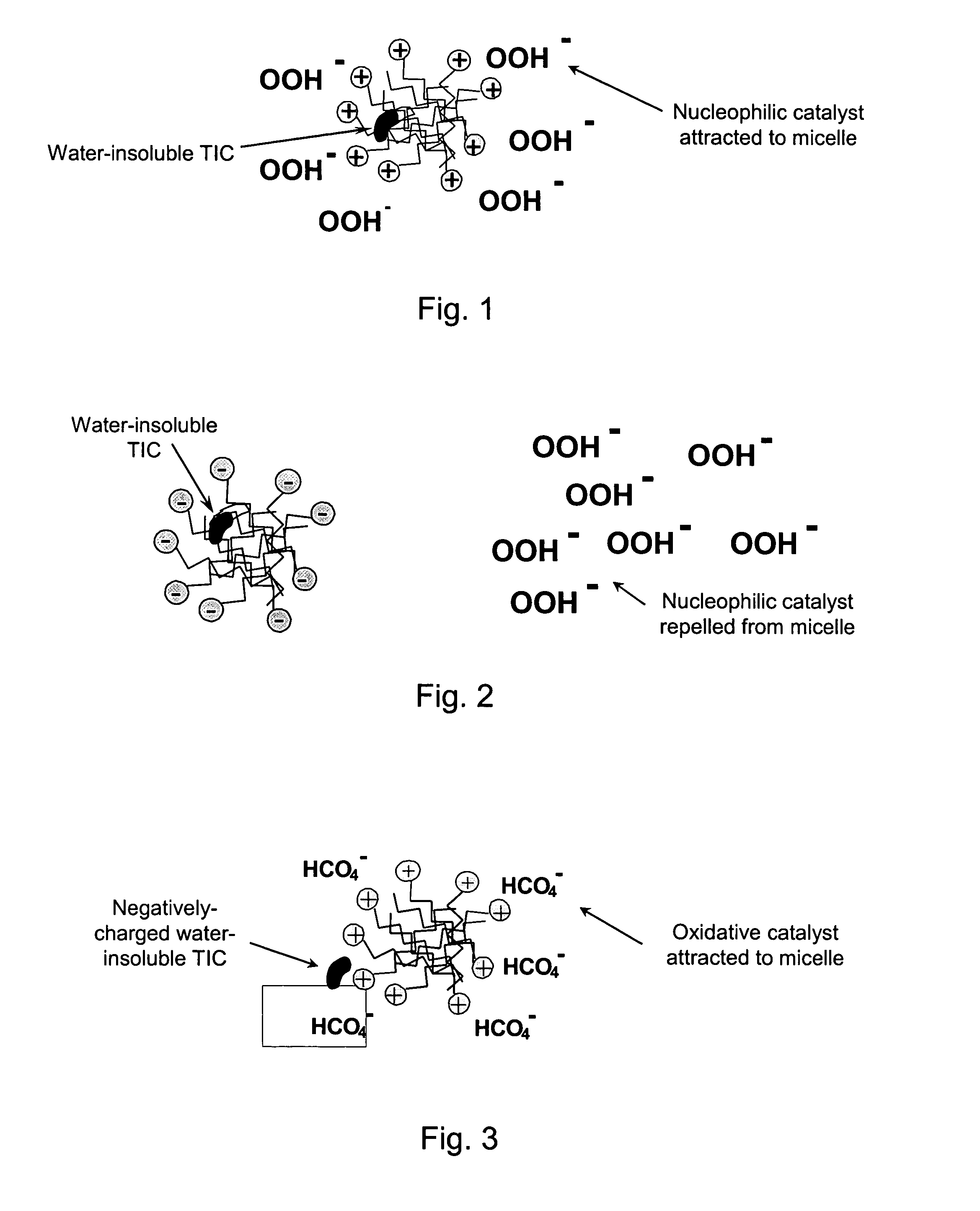Reactive formulations for a neutralization of toxic industrial chemicals
a technology of toxic industrial chemicals and reactive formulations, which is applied in the direction of liquid degasification, other chemical processes, separation processes, etc., can solve the problems of considerable technical challenge in the rapid decontamination of toxic industrial chemicals (tics), in both liquid and gaseous phases
- Summary
- Abstract
- Description
- Claims
- Application Information
AI Technical Summary
Benefits of technology
Problems solved by technology
Method used
Image
Examples
example # 1
Example #1
Concentration Ranges for Parts 1–5
[0079]Example #1 illustrates an example of suitable ranges of concentrations (by weight percent) of the various ingredients of Parts 1–5.[0080]Part 1 (Aqueous Component):[0081]0.1–10% Cationic Surfactant[0082]0–10% Cationic Hydrotrope[0083]1–10% Buffer / Alkalinity[0084]0–1% Foam Stabilizer[0085]0–30% Solvent[0086]0–40% Antifreeze[0087]0–8% Water-Soluble Polymer[0088]0–1% Corrosion Inhibitor[0089]Water (balance)[0090]Part 2 (Oxidant):[0091]1–30% Urea Hydrogen Peroxide[0092]Part 3 (Bleaching Activator):[0093]1–10% Propylene Glycol Diacetate or Glycerol Diacetate[0094]Part 4 (Reductant):[0095]0.1–5% Sodium Bisulfite[0096]Part 5 (Acid):[0097]0.1–2% Sodium Bisulfate or Citric Acid
[0098]The lower range for the optional ingredients, such as the foam stabilizer, solvent, antifreeze, water-soluble polymer, and corrosion inhibitor are set at zero. Some of these ingredients are included for foam stability and may be removed if it is desired to deploy ...
example # 2
Example #2
Formulation A
[0100]In this example, Part 2 of Formulation A is stored as a solid component (i.e., powdered form). Parts 1, 2 and 3 can be stored separately, in a kit configuration. The final made-up solution makes about 1 liter of activated solution ready for use.[0101]Part 1 (Liquid Formulation Component):[0102]20 g Variquat 80MC (Cationic Surfactant)[0103]10 g Adogen 477 (Cationic Hydrotrope)[0104]4 g 1-Dodecanol (Foam Stabilizer)[0105]90 g Propylene Glycol (Antifreeze)[0106]7.5 g Isobutanol (Solvent)[0107]50 g Potassium Carbonate (Buffer / Alkalinity)[0108]2 g Potassium Bicarbonate (Buffer / Alkalinity)[0109]1.5 g Celquat SC-240C (Polymer)[0110]750 g Water[0111]Part 2 (Solid Oxidant Component):[0112]97 g Urea Hydrogen Peroxide[0113]Part 3 (Liquid Bleaching Activator):[0114]20 g Glycerol Diacetate[0115]Note: The pH of the final formulation should be between 9.6 and 9.8. To mix this formulation, use the following procedure: mix Part 2 into Part 1. After dissolution of the ure...
example # 3
Example #3
Formulation A
[0116]In this example, Part 2 of Formulation A is stored as a liquid component (i.e., aqueous solution). Parts 1, 2 and 3 can be stored separately, in a kit configuration. The final made-up solution makes about 1 liter of activated solution ready for use.[0117]Part 1 (Liquid Formulation Component):[0118]20 g Variquat 80MC (Cationic Surfactant)[0119]10 g Adogen 477 (Cationic Hydrotrope)[0120]4 g 1-Dodecanol (Foam Stabilizer)[0121]90 g Propylene Glycol (Antifreeze)[0122]7.5 g Isobutanol (Solvent)[0123]50 g Potassium Carbonate (Buffer / Alkalinity)[0124]2 g Potassium Bicarbonate (Buffer / Alkalinity)[0125]1.5 g Celquat SC-240C (Polymer)[0126]315 g Water[0127]Part 2 (Solid Oxidant Component):[0128]433 g of 8% Hydrogen Peroxide solution[0129]Part 3 (Liquid Bleaching Activator):[0130]20 g Glycerol Diacetate[0131]Note: The pH of the final formulation should be between 9.6 and 9.8. To mix this formulation, use the following procedure: mix Part 1 and Part 2 together. Then,...
PUM
| Property | Measurement | Unit |
|---|---|---|
| temperature | aaaaa | aaaaa |
| agglomerate size | aaaaa | aaaaa |
| solubilizing | aaaaa | aaaaa |
Abstract
Description
Claims
Application Information
 Login to View More
Login to View More - R&D
- Intellectual Property
- Life Sciences
- Materials
- Tech Scout
- Unparalleled Data Quality
- Higher Quality Content
- 60% Fewer Hallucinations
Browse by: Latest US Patents, China's latest patents, Technical Efficacy Thesaurus, Application Domain, Technology Topic, Popular Technical Reports.
© 2025 PatSnap. All rights reserved.Legal|Privacy policy|Modern Slavery Act Transparency Statement|Sitemap|About US| Contact US: help@patsnap.com



